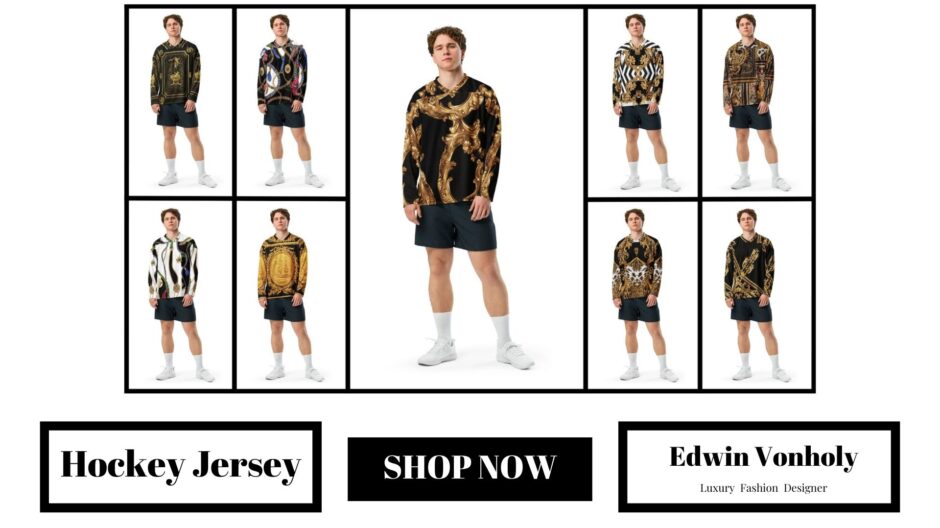Buying a custom hockey jersey isn’t just about colors and logos—it’s about investing in something that will last on and off the ice. Whether you’re ordering for a team, a league, or personal use, not all jerseys are created equal. From fabric durability to stitching and customization techniques, here’s how to spot a high-quality custom hockey jersey before you spend your hard-earned money.

1. Check the Fabric Type and Weight
The material of the jersey affects everything from comfort to durability. Most high-quality hockey jerseys are made from air-knit polyester or pro-weight mesh.
What to Look For:
- Heavyweight polyester (200+ gsm) for game play
- Breathable mesh panels for ventilation
- Tear-resistant, snag-proof weaves
Avoid cheap, shiny materials that feel thin or overly stretchy—these won’t hold up to real use.
2. Inspect the Stitching and Construction
The quality of stitching is a big indicator of jersey durability. Poor stitching will fray, unravel, or cause logos and numbers to peel or fall off.
High-Quality Signs:
- Double stitching along seams and logos
- Tight, even thread work with no loose threads
- Reinforced shoulders and side panels
If you can see gaps, loose ends, or uneven stitching—skip it.
3. Evaluate the Customization Method
There are three main customization techniques used for custom hockey jerseys:
A. Tackle Twill (Sewn Letters/Numbers)
- Most durable and premium option
- Letters and numbers are stitched onto the jersey
- Looks and feels authentic
B. Sublimation Printing
- Graphics are dyed directly into the fabric
- Won’t crack, peel, or fade
- Ideal for complex designs or full-color logos
C. Heat Press or Vinyl
- Budget-friendly but less durable
- Can crack or peel after repeated washing
- Best for short-term use or fan jerseys
For performance jerseys, stick with tackle twill or sublimation.
4. Review Sizing and Fit Options
A good custom jersey provider will offer accurate sizing charts and multiple fits (e.g., pro fit, standard fit, or youth sizes).
What to Expect:
- Size ranges from Youth Small to Adult 3XL or higher
- Roomy arms and torso for pads (for game jerseys)
- Custom length or sleeve adjustments, if needed
Poorly sized jerseys limit comfort and playability, so confirm size specs before buying.
5. Look for Quality Collar and Neckline Construction
The neckline should be durable and well-fitted—not loose, thin, or uneven.
Features of a Quality Collar:
- Double-layered or ribbed necklines
- Reinforced seams around the collar
- Lace-up or V-neck options with solid finishes
Avoid jerseys with floppy, wrinkled, or stitched-over collars—these are often signs of low-tier construction.
6. Confirm Logo Clarity and Color Accuracy
Your logo is the face of your jersey, so it should look crisp and vibrant.
Look for:
- Sharp edges with no pixelation or blurring
- True-to-design color matching
- Embroidered or high-resolution prints
Request a digital mock-up or sample proof before placing a full order.
7. Ask About Wash Durability
A great-looking jersey is only valuable if it stays that way after washing.
Good Signs:
- Won’t shrink or warp in cold water
- Logos and numbers remain intact after multiple washes
- No fading or cracking over time
Ask the manufacturer for washing instructions and material specs before committing.
8. Review the Manufacturer’s Reputation
Always research the company or vendor. Quality jerseys come from companies with:
- Positive customer reviews
- Clear communication and proofing process
- Experience with team or league orders
Check for customer photos, online ratings, and delivery timelines to avoid cheap or poorly made gear.
9. Compare Pricing Carefully
While you want a fair price, extremely cheap custom jerseys often signal poor materials or rushed craftsmanship.
Pricing Range (Per Jersey):
- Basic fan jerseys: $30–$50
- Sublimated team jerseys: $50–$80
- Tackle twill pro jerseys: $80–$120+
Always balance cost with quality and longevity.
10. Request Samples or Prototypes
Before placing a full team or bulk order, ask for a sample jersey or small-batch run.
Why it helps:
- Lets you check fit, fabric, and printing quality in hand
- Ensures the logo looks right and colors are accurate
- Builds confidence before a large investment
Final Thoughts
A quality custom hockey jersey should feel as tough as it looks—ready to survive a full season of checks, sweat, and celebration. By checking fabric quality, stitching, customization methods, and manufacturer reputation, you can confidently invest in a jersey that looks great and lasts. Don’t settle for flashy designs with flimsy build—true hockey pride deserves gear that performs as hard as you do.
